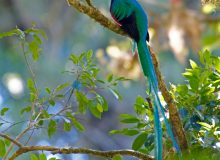-

Return of Bird of the Week: Magellanic Penguin
This is late going up. Sorry. WC will stay with penguins just a little bit longer because flightless birds are cool, too. The Magellanic Penguin is unusual in several ways. First, it is the only species of bird in the range that has a breeding colony protected by land mines. You can’t make this stuff up. The Magellanic Penguins’ range includes the Falkland Islands in the South Atlantic. In the Argentine-Britain War in 1982, the Argentines placed land mines on several beaches. One of those beaches was the site of a large Magellanic Penguin colony, empty of penguins at the…
-

Return of Bird of the Week: Chinstrap Penguin
The thing is, it really does look like a chinstrap, holding that black “helmet” on to their heads. That thin line of black feathers gives the species its name, although they are also called Stonecrackers for the harshness of their calls. This is circumpolar species, with an estimated world population of about 8 million birds. They are dietary generalists, feeding on krill, squid, shrimp and small fish, which gives them an advantage over some of their more specialist cousins. When WC was at this small colony on Deception Island in early December, courtship was just getting started and the birds…
-

Return of Bird of the Week: Macaroni Penguin
Macaroni Penguins, despite their silly name, are another amazing mountaineering species of penguin. These photos are all from a bouncing Zodiac rubber raft; we couldn’t make a landing where the Macaroni Penguins routinely did. Note the different bill structure. The Macaroni’s bill is adapted for a different genus of krill, its primary prey, resulting the bulbous shape. The feathers in the crown appear to be a sexual display thing. This is the landing for the Macaroni colony. Note the areas of bare rock, where the algae and barnacles are worn off by the passage of thousands of Macaroni feet. This…
-

Return of Bird of the Week: Rockhopper Penguin
One of the striking things about penguins is the steep-sided hillsides some species favor and climb to get to their rookeries. As you watch a flightless penguin waddle along, mountain-climbing isn’t the kind of skill you expect. And among the best climbers is the Rockhopper Penguin. Rockhoppers are a sub-antarctic species. These photos are from a rookery at West Point Island in the Falkland Islands. The rookery is located on a steep, rocky headland, shared with Black-browed Albatrosses and King Shags (Cormorants). It’s about 800 feet above the South Atlantic. The Rockhoppers climb that steep, slippery, rocky slope multiple times…
-

Return of Bird of the Week: Adélie Penguin
If WC has a favorite penguin, among the ten or so species he has seen, it has to be the Adélie Penguin. This bird is all business, all of the time. Partly, that’s because they are the most southerly-dwelling of all the penguin species. Emperor Penguins famously breed further south, but when Emperor chicks are fledged the species heads north. Adélies, by contrast, remain at the southernmost edge of open water year-round. As a species, Adélies are doing all right globally, but in the area of the Antarctic Peninsula, where WC saw them, they are in deep trouble, Adélies are…
-
Return of Bird of the Week: Magellanic Penguin
Jun 2, 2018
-
Return of Bird of the Week: Chinstrap Penguin
May 26, 2018
-
Return of Bird of the Week: Macaroni Penguin
May 19, 2018
-
Return of Bird of the Week: Rockhopper Penguin
May 12, 2018
-
Return of Bird of the Week: Adélie Penguin
May 5, 2018
Headlines

Return of Bird of the Week: Magellanic Penguin
This is late going up. Sorry. WC will stay with penguins just a little bit longer because flightless birds are cool, too. The Magellanic Penguin is unusual in several ways. First, it is the only species of bird in the range that has a breeding colony protected by land mines. You can’t make this stuff up. The Magellanic Penguins’ range includes the Falkland Islands in the South Atlantic. In the Argentine-Britain War in 1982, the Argentines placed land mines on several beaches. One of those beaches was the site of a large Magellanic Penguin colony, empty of penguins at the…

Return of Bird of the Week: Chinstrap Penguin
The thing is, it really does look like a chinstrap, holding that black “helmet” on to their heads. That thin line of black feathers gives the species its name, although they are also called Stonecrackers for the harshness of their calls. This is circumpolar species, with an estimated world population of about 8 million birds. They are dietary generalists, feeding on krill, squid, shrimp and small fish, which gives them an advantage over some of their more specialist cousins. When WC was at this small colony on Deception Island in early December, courtship was just getting started and the birds…

Return of Bird of the Week: Macaroni Penguin
Macaroni Penguins, despite their silly name, are another amazing mountaineering species of penguin. These photos are all from a bouncing Zodiac rubber raft; we couldn’t make a landing where the Macaroni Penguins routinely did. Note the different bill structure. The Macaroni’s bill is adapted for a different genus of krill, its primary prey, resulting the bulbous shape. The feathers in the crown appear to be a sexual display thing. This is the landing for the Macaroni colony. Note the areas of bare rock, where the algae and barnacles are worn off by the passage of thousands of Macaroni feet. This…

Return of Bird of the Week: Rockhopper Penguin
One of the striking things about penguins is the steep-sided hillsides some species favor and climb to get to their rookeries. As you watch a flightless penguin waddle along, mountain-climbing isn’t the kind of skill you expect. And among the best climbers is the Rockhopper Penguin. Rockhoppers are a sub-antarctic species. These photos are from a rookery at West Point Island in the Falkland Islands. The rookery is located on a steep, rocky headland, shared with Black-browed Albatrosses and King Shags (Cormorants). It’s about 800 feet above the South Atlantic. The Rockhoppers climb that steep, slippery, rocky slope multiple times…

Return of Bird of the Week: Adélie Penguin
If WC has a favorite penguin, among the ten or so species he has seen, it has to be the Adélie Penguin. This bird is all business, all of the time. Partly, that’s because they are the most southerly-dwelling of all the penguin species. Emperor Penguins famously breed further south, but when Emperor chicks are fledged the species heads north. Adélies, by contrast, remain at the southernmost edge of open water year-round. As a species, Adélies are doing all right globally, but in the area of the Antarctic Peninsula, where WC saw them, they are in deep trouble, Adélies are…

“Am I Being Detained?” Visu.News Interviews Jeanne Devon on Sovereign Citizens
This week on the Visu.News podcast I chat with long time friend and colleague Jeanne Devon. She’s the editor and founder of TheMudflats.net – if you read anything about Sarah Palin back in 2008, it’s likely a story that she wrote and then was picked up by the networks. This week she’s on to talk “sovereign citizens” (the Waffle House shooter likely was one) and the new book she co-wrote with former undercover FBI operative Bill Fulton, who is now a Visu.News regular. That book is, of course, The Blood of Patriots – now available everywhere fine books are sold. As I…

Return of Bird of the Week: King Penguin
This week – and for the next few weeks – we’ll spend some time in the Southern Ocean. Specifically, on the extraordinary South Georgia Island. South Georgia offers concentrations of wildlife that are simply incredible. Not the least of those concentrations are the breeding colonies of King Penguins. The breeding colony at Salisbury Plain may be the largest number of breeding animals at once place left on this planet. Up to 100,000 King Penguins breed there. Ridiculously handsome, photogenic and charismatic, the King Penguin is the poster child for its clade, Spheniscidae, the penguin family. It was a privilege to visit…

Neo-Nazi Flees Arrest, Declares Run for Senate
A man wanted for entering The Church of Love in the Anchorage neighborhood of Spenard and unloading a can of bear mace on a group of peace activists is now officially identified, arrested without incident, and in police custody. Bret Maness, an avowed white supremacist, has been charged with fourteen counts including a first-degree felony charge of making a terroristic threat, a second-degree burglary charge, 11 counts of fourth-degree assault, and one count of reckless endangerment. The call to the community went out via Nixle alert on Thursday morning at 8:30 stating that the public had been instrumental in identifying Maness…

Return of Bird of the Week: Resplendant Quetzal
WC has been accused of posting photos of boring birds. While there are no boring birds, it’s true that some have broader appeal than others. So here’s a lot of folks’ candidate for the most beautiful bird in the Western Hemisphere, the Resplendant Quetzal. The bird is about 15 inches long, plus about 26 inches of tail. It’s iridescent green blue and red, and seen live absolutely takes you breath away. A member of the Trogon family, it is considered divine by Mesoamerican peoples. It is certainly spectacular, and WC counts himself luck to have been able to see and…

Return of Bird of the Week: Long-tailed Tyrant
There are a staggering, bewildering number of birds in the Neotropics that eat bugs. Hundreds of species of flycatchers, alone. One of the more spectacular is the Long-tailed Tyrant. Long-tailed Tyrants feed exclusively on flying insects, especially stingless bees. Insects are captured by making quick aerial sallies from a high exposed snag or branch. Not coincidentally, that perching makes them easy to photograph. The species has an extensive range, from Honduras to Brazil, The species is described as “fairly common but patchily distributed,” but the total population is unknown and the species is, in the phrasing of ornithology, “poorly understood.” Despite that long tail,…












